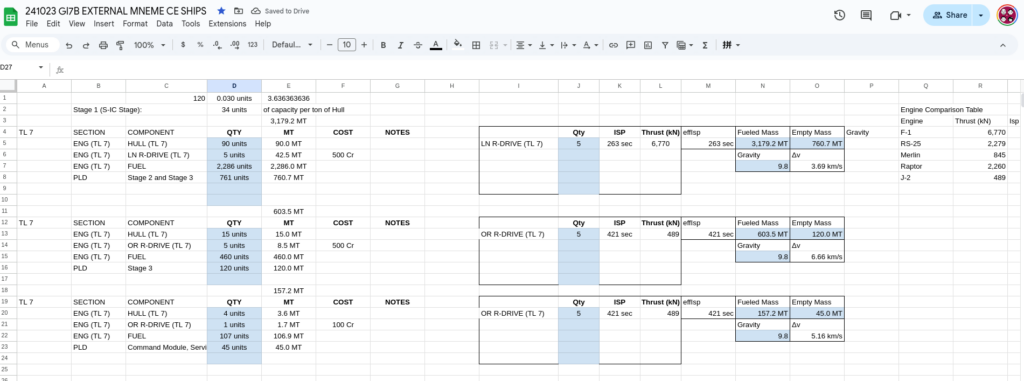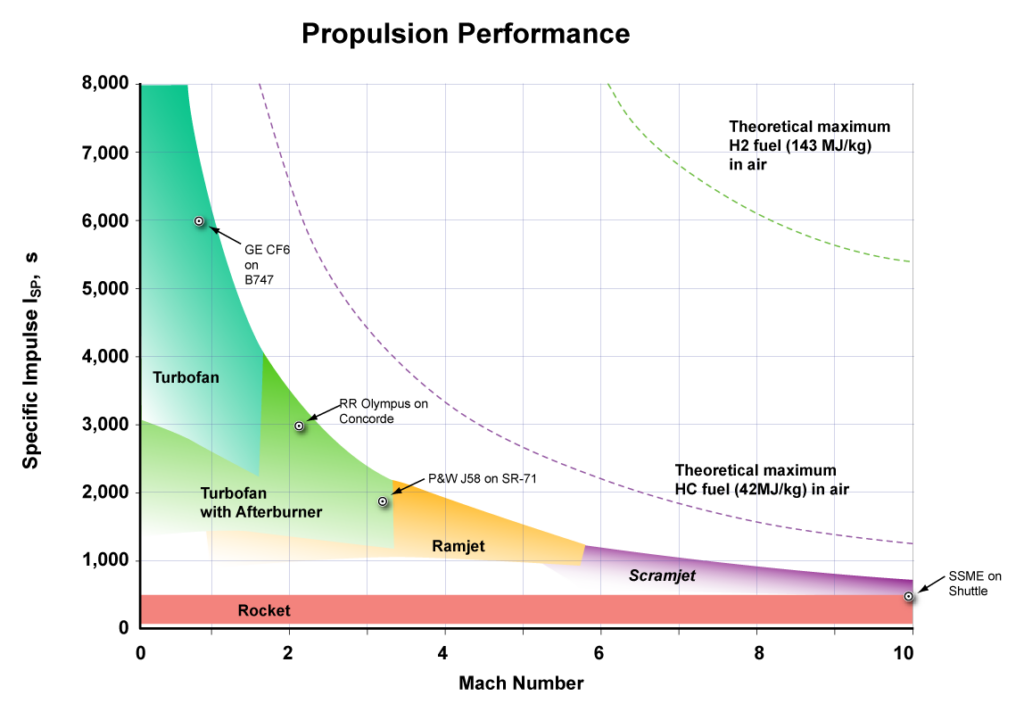
I’m working on developing a Cepheus Engine Ship Generator spreadsheet that will handle all the calculations necessary for ship design and performance assessment. Here are the main challenges I’m tackling:
- Effective Impulse Calculation: Implementing the formula for effective impulse is complex in a spreadsheet format. Given that each variable (P, Q, R, etc.) requires extensive handling, it will result in a lengthy, multi-column table.
- Mass Flow Rate and Burn Time: I need to set up calculations for the mass flow rate that indicate the burn duration across all thrusters. This will reveal how quickly each ship expends fuel, which is key for managing Delta-V calculations.
- Ion Drive Modeling: Ion drives pose a unique challenge due to their extraordinary Delta-V capabilities combined with extremely low thrust. Modeling their acceleration accurately, which often spans quarters or even years, will require an approach that accommodates prolonged low-thrust burns.
Looking forward, here are the project goals:
Maintaining the GI7B Wiki: This will be a living document, where we detail the timelines, technologies, and ongoing events influencing the Mneme setting. The Wiki will cover everything from foundational infrastructure to the evolutionary paths of different tech levels.
Rebuilding the CE Ship Delta-V Budgets: I plan to redo all existing CE ships with accurate Delta-V budgeting. I’ll be commissioning Nicco to redesign ships capable of landing with both vertical and hybrid layouts to reflect real-world capabilities.
Infrastructure Elements: I’m incorporating calculations and designs for critical infrastructure:
Sky Hooks that facilitate Delta-V exchange in low Earth orbit,
Hybrid airships with winged bodies designed to launch jet-rocket hybrids near orbit,
Space Elevators (reference: The Space Elevator: A Revolutionary Earth-to-Space Transportation System by Bradley C. Edwards and Eric A. Westling),
Early Habitats and Spin Habitats, incorporating Ian Long’s concepts for lunar development.
Apollo Saturn V Mission Overview and Delta-V Budget
The Saturn V mission to the Moon required a total Delta-V budget of approximately 17.06 km/s to go from Earth to the Moon and return. Each stage contributed a specific portion of this budget to overcome gravitational and orbital challenges, from launching off Earth to landing on and then departing from the lunar surface.
- Stage 1 (S-IC):
- Role: The S-IC stage was the main liftoff engine, with enough Delta-V to launch the entire rocket (including all stages and modules) from Earth’s surface and into the upper atmosphere.
- Delta-V Contribution: Significant portion of the 14 km/s required to escape Earth’s gravity.
- Fuel Type: RP-1/LOX.
- Stage 2 (S-II):
- Role: After the S-IC stage is jettisoned, the S-II stage ignites to further accelerate the payload, pushing the spacecraft closer to orbital velocity.
- Delta-V Contribution: Completes a large portion of the remaining Delta-V needed for orbital insertion.
- Stage 3 (S-IVB):
- Role: Stage 3 has a critical job in reaching the Moon. It provides the Delta-V for trans-lunar injection (TLI), the maneuver that sends the spacecraft from Earth orbit toward the Moon.
- Delta-V Contribution: Completes the 14 km/s Earth escape velocity, then an additional 3 km/s for lunar transit.
- Service Module (SM):
- Role: Often called a “4th stage,” the Service Module (SM) performs the final maneuvers to enter and maintain lunar orbit, dock with the Lunar Module, and ultimately return the Command Module to Earth.
- Delta-V Contribution: About 1.2 km/s for lunar orbit adjustments and trans-Earth injection for returning to Earth.
- Lunar Descent Module (DPS):
- Role: The DPS of the Lunar Module provides controlled descent from lunar orbit to the Moon’s surface.
- Delta-V Contribution: Approximately 1.8 km/s to safely brake and descend for a soft lunar landing.
- Lunar Ascent Module (APS):
- Role: After lunar surface operations, the APS ignites to launch the Lunar Module back into lunar orbit, where it docks with the Command and Service Modules for the return journey.
- Delta-V Contribution: Enough to reach lunar orbit and complete docking maneuvers.
- Command Module (CM):
- Role: With a small Delta-V budget, the Command Module performs minor orientation adjustments upon re-entry.
- Atmospheric Entry and Parachute Deployment: The heat shield protects the module from re-entry heat, while the parachutes are deployed only after the module has decelerated sufficiently to ensure safe deployment.
Total Delta-V Summary
- Total Mission Delta-V: 17.06 km/s.
- Earth Escape Velocity: 14 km/s
- Lunar Orbital and Surface Operations: ~3 km/s
- Lunar Landing: Approximately 1.8 km/s
Each stage’s unique Delta-V contribution combines to meet the requirements of the Apollo mission, with the Service Module acting as a tender to the Moon and back, and the Lunar Module (both Descent and Ascent) handling the lunar landing and ascent to complete the round-trip mission.
With this Delta-V budget, Saturn V not only succeeded in reaching the Moon but also laid the foundation for understanding and planning interplanetary missions at varying technology levels, from TL 7 Saturn V missions to TL 8 rockets like the Space Shuttle, Soyuz, Falcon, and Super Heavy.
Tech Level 8 (2000-2050): Foundation of Modern Spacefaring
- Focus: TL 8 represents the era of Earth-centered space infrastructure. Modern rockets like the Falcon series, Space Shuttle, Soyuz, and Super Heavy serve as the foundation for humanity’s exploration efforts. Innovations in reusability, efficiency, and precise orbital mechanics allow for new missions to the Moon and Mars.
- Mneme Worldview: This era is driven by the groundwork for a high-trust, interconnected society. Technology increases, but humanity is still learning how to collaborate effectively across borders, classes, and ideologies. Economic growth and technological expertise expand to a broader demographic, encouraging the emergence of inclusive, empathetic leadership and social networks capable of handling complex societal needs.
- Milestones: Establishing Moon bases, sustainable orbital infrastructure, and Earth-Moon logistical chains. Beginning to view the Moon as a military and economic milestone, where orbital dominance and lunar resource extraction redefine Earth’s strategic landscape.
Tech Level 9 (2050-2099): Interplanetary Expansion and Cultural Reawakening
- Focus: TL 9 centers on humanity’s sustained and scalable presence in space, including interplanetary travel within our solar system. Missions are now long-term and self-sustaining, supported by advanced resource utilization, efficient propulsion, and innovations in life support systems.
- Mneme Worldview: Humanity recognizes the need for resilience and adaptability. TL 9 is a period of cultural preservation and rediscovery, where many groups, especially from underrepresented or developing regions, use the “space frontier” to protect and expand their cultural identities. This level of inclusivity fosters a sense of belonging and representation in the new space economy.
- Milestones: Expanded infrastructure on Mars, asteroid mining, and possibly manned missions to the outer solar system. This period marks the start of the intra-solar economy, where lunar and Martian resources support Earth’s orbit and provide new pathways for cultural and economic autonomy.
Tech Level 10 (2100-2199): System-wide Civilization
- Focus: By TL 10, humanity has a system-wide presence, with advanced habitats on Mars, in the asteroid belt, and across moons like Europa and Titan. Massive-scale engineering projects allow for megastructures and solar-powered space stations, paving the way for energy abundance and independence from Earth.
- Mneme Worldview: Inspired by speculative sci-fi and optimistic transhumanism, TL 10 society aims to escape the zero-sum mentality by leveraging resources from across the solar system. The cultural and economic structures emphasize non-zero-sum interactions, where technological advancements focus on mutually beneficial outcomes and sustainable expansion.
- Milestones: Efficient and reliable travel across the solar system, self-sufficient off-world colonies, and advanced AI governance systems that help manage the complexity of interplanetary economics. Society has established a high-trust, high-empathy model, aiming for peaceful collaboration across vast distances.
Long-Term Vision: Toward an Interstellar Humanity
As humanity reaches the interstellar levels in the 2300s, Mneme imagines a world where cultural and genetic diversity flourish across distant star systems. Inspired by speculative narratives like Vinland Saga’s themes of exploration, escape, and renewal, this future envisions:
- Recreation of Lost Cultures: After centuries of space colonization, distant worlds will embody diverse aspects of Earth’s past, preserving and reinventing cultural identities thought to be at risk of erasure. The vastness of space offers a unique freedom to preserve and reawaken cultural values in new environments.
- A Non-Zero-Sum Future: With access to the vast resources of interstellar space, human society may finally overcome the zero-sum conflicts that have plagued history. Interstellar expansion represents humanity’s best chance at a future free from scarcity-driven conflicts, allowing for a renaissance of cultural, scientific, and technological achievements.
- Building Resilient Interconnected Communities: Each interstellar colony could become a self-sustaining, interconnected hub that upholds high trust and empathy, fostering peace and autonomy within each unique environment.
Conclusion: Mneme’s Framework and the Hope for Humanity
Mneme’s setting offers a unique perspective on humanity’s evolution: one that combines practical foresight about technological progress with a hopeful and inclusive vision for social progress. This framework prioritizes collaboration, empathy, and cultural preservation alongside technological advancement, crafting a world where diverse human societies can thrive in the vastness of space. As humanity expands, so does its understanding of itself, leading to a civilization that may one day celebrate both cultural diversity and universal unity across countless stars.
There exist projects to preserve cultures and identities, such as https://savewisdom.org/the-1000-word-save-wisdom-questions/ . As we learn more about AI, we learn that we can preserve our values and beliefs in data, and while humanity will consolidate and singularize as part of the need to reduce conflict.
If there is a heaven – and heaven is dependent on cultures, peoples, beliefs, and relationships – then the stars will become the heavens created by humans.
https://en.wikipedia.org/wiki/Specific_impulse



Leave a Reply
You must be logged in to post a comment.